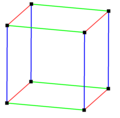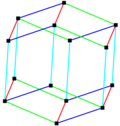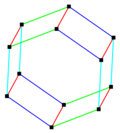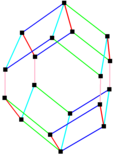.
Parallelohedron
In geometry a parallelohedron is a polyhedron that can tessellate 3-dimensional spaces with face-to-face contacts via translations. This requires all opposite faces be congruent. Parallelohedra can only have parallelogonal faces, either parallelograms or hexagons with parallel opposite edges.
There are 5 types, first identified by Evgraf Fedorov in his studies of crystallographic systems.
Topological types
The vertices of parallelohedra can be computed by linear combinations of 3 to 6 vectors. Each vector can have any length greater than zero, with zero length becoming degenerate, or becoming a smaller parallelohedra.
The greatest parallelohedron is a truncated octahedron which is also called a 4-permutahedron and can be represented with in a 4D in a hyperplane coordinates as all permutations of the counting numbers (1,2,3,4).
A belt mn means n directional vectors, each containing m coparallel congruent edges. Every type has order 2 Ci central inversion symmetry in general, but each has higher symmetry geometries as well.
Symmetries of 5 types
There are 5 types of parallelohedra, although each has forms of varied symmetry.
High symmetric examples
| Pm3m (221) | Im3m (229) | Fm3m (225) | ||
|---|---|---|---|---|
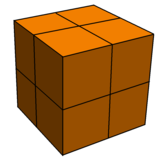 |
 |
 |
 |
 |
| Cubic |
Hexagonal prismatic |
Rhombic dodecahedral |
Elongated dodecahedral | Bitruncated cubic |
General symmetry examples
 |
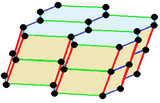 |
 |
See also
parallelogon - analogous space-filling polygons in 2D, with parallelograms and hexagons
parallelotope
References
The facts on file: Geometry handbook, Catherine A. Gorini, 2003, ISBN 0-8160-4875-4, p.117
Coxeter, H. S. M. Regular polytopes (book), 3rd ed. New York: Dover, pp. 29-30, p.257, 1973.
Tutton, A. E. H. Crystallography and Practical Crystal Measurement, 2nd ed. London: Lubrecht & Cramer, 1964.
Weisstein, Eric W., "Primary parallelohedron", MathWorld.
Weisstein, Eric W., "Space-filling polyhedron", MathWorld.
E. S. Fedorov, Nachala Ucheniya o Figurah. [In Russian] (Elements of the theory of figures) Notices Imper. Petersburg Mineralog. Soc., 2nd ser.,24(1885), 1 – 279. Republished by the Acad. Sci. USSR, Moscow 1953.
Fedorov's five parallelohedra in R³
Fedorov's Five Parallelohedra
Retrieved from "http://en.wikipedia.org/"
All text is available under the terms of the GNU Free Documentation License

